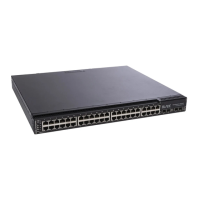© Copyright IBM Corp. 2011 Chapter 13. Stacking 151
Merging Independent Stacks
If switches from different stacks are linked together in a stack topology without first
reconfiguring their roles as recommended, it is possible that more than one switch in
the stack might be configured as a Master.
Although all switches which are configured for stacking and joined by stacking links
are recognized as potential stack participants by any operational Master switches,
they are not brought into operation within the stack until explicitly assigned (or
“bound”) to a specific Master switch.
Consider two independent stacks, Stack A and Stack B, which are merged into one
stacking topology. The stacks will behave independently until the switches in
Stack B are bound to Master A (or vice versa). In this example, once the Stack B
switches are bound to Master A, Master A will automatically reconfigure them to
operate as Stack A Members, regardless of their original status within Stack B.
However, for purposes of future Backup selection, reconfigured Masters retain their
identity as configured Masters, even though they otherwise act as Members and
lose all settings pertaining to their original stacks.
Backup Switch Selection
An operational stack can have one optional Backup at any given time. Only the
Backup specified in the active Master’s configuration is eligible to take over current
stack control when the Master is rebooted or fails. The Master automatically
synchronizes configuration settings with the specified Backup to facilitate the
transfer of control functions.
The Backup retains its status until one of the following occurs:
•
The Backup setting is deleted or changed using the following commands from
the active Master:
•
A new Master assumes operation as active Master in the stack, and uses its own
configured Backup settings.
•
The active Master is rebooted with the boot configuration set to factory defaults
(clearing the Backup setting).
Master Failover
When the Master switch is present, it controls the operation of the stack and pushes
configuration information to the other switches in the stack. If the active Master fails,
then the designated Backup (if one is defined in the Master’s configuration)
becomes the new acting Master and the stack continues to operate normally.
Secondary Backup
When a Backup takes over stack control operations, if any other configured Masters
(acting as Member switches) are available within the stack, the Backup will select one
as a secondary Backup. The primary Backup automatically reconfigures the secondary
Backup and specifies itself (the primary Backup) as the new Backup in case the
secondary fails. This prevents the chain of stack control from migrating too far from the
original Master and Backup configuration intended by the administrator.
RS G8000(config)# no stack backup
-or-
RS G8000(config)# stack backup <csnum 1-6>

